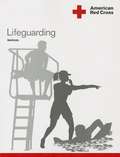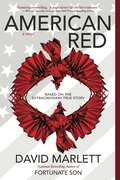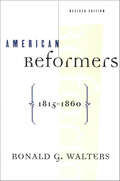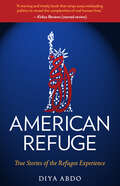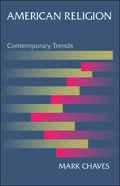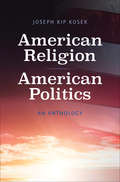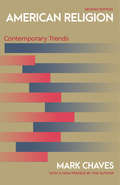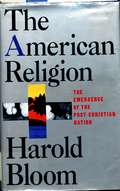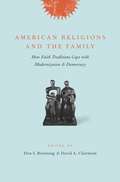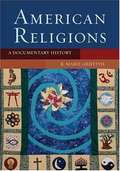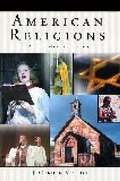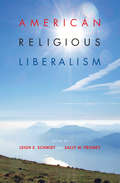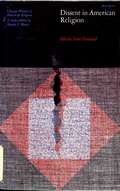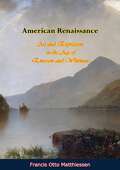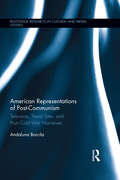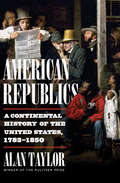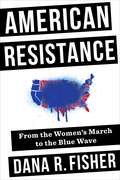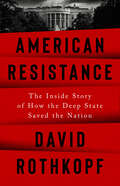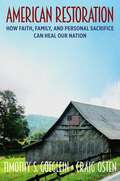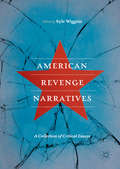- Table View
- List View
American Red Cross Lifeguarding Manual
by American Red CrossDesigned to simplify learning, the participants manual reinforces key points from the course. The manual can also be used as a reference for working lifeguards after the course.
American Red Cross Swimming and Water Safety
by American Red CrossPeople are drawn to water. Look at any waterfront and you will likely see boardwalks, beaches, bike paths, marinas and plenty of people enjoying themselves. Couples and students on spring break seek tropical beaches as vacation spots while families flock to waterparks and lake cabins. Commercial fishermen and mariners take to the water for their livelihoods. Water is an important part of our lives.
American Red: A Novel
by David MarlettThe Great American Century begins, the modern world roars to life, Capitalists flaunt greed and seize power, Socialists and labor unions flex their violent will, and an extraordinary true story of love and sacrifice unfolds.The men and women of American R ed are among the most fascinating in American history. When, at the dawn of the 20th century, the Idaho governor is assassinated,blame falls on &“Big Bill&” Haywood, the all-powerful, one-eyed boss of the Western Fed- eration of Miners in Denver. Close by, his polio-crippled wife, Neva, struggles with her wavering faith, her love for another man, and her sister's affair with her husband.New technologies accelerate American life, but justice lags behind. Private detectives, bat- tling socialists and unions on behalf of wealthy capitalists, will do whatever it takes to seeHaywood hanged. The scene is set for bloodshed, from Denver to Boise to San Francisco.America's most famous attorney, Clarence Darrow, leads the defense—a philandering U.S. senator leads the prosecution—while the press, gunhands, and spies pour in.Among them are two idealists, Jack Garrett and Carla Capone—he a spy for the prosecu- tion, she for the defense. Risking all, they discover truths about their employers, about themselves and each other, and what they'll sacrifice for justice and honor—and for love.
American Reformers, 1815–1860
by Ronald G. WaltersFor this new edition of American Reformers 1815-1860, Ronald G. Walters has amplified and updated his exploration of the fervent and diverse outburst of reform energy that shaped American history in the early years of the Republic. Capturing in style and substance the vigorous and often flamboyant men and women who crusaded for such causes as abolition, temperance, women's suffrage, and improved health care, Walters presents a brilliant analysis of how the reformers' radical belief that individuals could fix what ailed America both reflected major transformations in antebellum society and significantly affected American culture as a whole.
American Refuge: True Stories of the Refugee Experience (Truth to Power)
by Diya Abdo&“A moving and timely book that strips away misleading politics to reveal the complexities of real human lives." — Kirkus Reviews (starred review)A provocative, conversation-sparking exploration of refugee experiences told in their own words, for readers of Karla Cornejo Villavicencio&’s The Undocumented Americans and Viet Thanh NguyenForced to leave their homes, they came to America...In this intimate and eye-opening book, Diya Abdo--daughter of refugees, U.S. immigrant, English professor, and activist—shares the stories of seven refugees. Coming from around the world, they&’re welcomed by Every Campus A Refuge (ECAR), an organization Diya founded to leverage existing resources at colleges to provide temporary shelter to refugee families.Bookended by Diya&’s powerful essay "Radical Hospitality" and the inspiring coda &“Names and Numbers,&” each chapter weaves the individual stories into a powerful journey along a common theme: Life Before (&“The Body Leaves its Soul Behind&”) The Moment of Rupture (&“Proof and Persecution&”) The Journey (&“Right Next Door&”) Arrival/Resettlement (&“Back to the Margins&”) A Few Years Later (&“From Camp to Campus&”) The lives explored in American Refuge include the artist who, before he created the illustration on the cover of this book, narrowly escaped two assassination attempts in Iraq and now works at Tyson cutting chicken.We learn that these refugees from Burma, Burundi, Iraq, Palestine, Syria, and Uganda lived in homes they loved, left against their will, moved to countries without access or rights, and were among the 1% of the "lucky" few to resettle after a long wait, almost certain never to return to the homes they never wanted to leave. We learn that anybody, at any time, can become a refugee.
American Regulatory Federalism and Telecommunications Infrastructure (LEA Telecommunications Series)
by Paul TeskeDuring this era of construction of the information superhighway, this volume presents a prudent analysis of the pros and cons of continuing state regulation of telecommunications. While interested parties either attack or defend state regulation, careful scholarly analysis is required to strike the appropriate balance of regulatory federalism. Focusing on regulation in the 1990s, it uses a positive political economy perspective to analyze enduring state-federal conflicts and to weigh the justifications and explanations for continuing state telecommunications regulation, or for changing its structure. It also considers normative concerns and makes recommendations about how to improve telecommunications policy. Seriously concerned with assessing the problems surrounding cost burdens for different categories of consumers, market entry for different firms, economic growth and the information infrastructure, global competitiveness, and control over information, this volume attempts to provide answers to the following specific questions: * How are states regulating telecommunications in the brave new world of global markets, fiber optics, and digital technology? * Do states vary significantly in their regulatory models? * How are the politics of state and federal regulation different? * Would a different federal-state relationship better serve national telecommunications goals in the future? To tackle these critical questions, the scholarly perspectives of economists, lawyers, political scientists, and telecommunications consultants and practitioners are employed.
American Religion
by Mark ChavesMost Americans say they believe in God, and more than a third say they attend religious services every week. Yet studies show that people do not really go to church as often as they claim, and it is not always clear what they mean when they tell pollsters they believe in God or pray. American Religion presents the best and most up-to-date information about religious trends in the United States, in a succinct and accessible manner. This sourcebook provides essential information about key developments in American religion since 1972, and is the first major resource of its kind to appear in more than two decades. Mark Chaves looks at trends in diversity, belief, involvement, congregational life, leadership, liberal Protestant decline, and polarization. He draws on two important surveys: the General Social Survey, an ongoing survey of Americans' changing attitudes and behaviors, begun in 1972; and the National Congregations Study, a survey of American religious congregations across the religious spectrum. Chaves finds that American religious life has seen much continuity in recent decades, but also much change. He challenges the popular notion that religion is witnessing a resurgence in the United States--in fact, traditional belief and practice is either stable or declining. Chaves examines why the decline in liberal Protestant denominations has been accompanied by the spread of liberal Protestant attitudes about religious and social tolerance, how confidence in religious institutions has declined more than confidence in secular institutions, and a host of other crucial trends.
American Religion, American Politics: An Anthology
by Jon Butler Joseph Kip KosekEssential primary sources reveal the central tensions between American politics and religion throughout the nation’s history Despite the centrality of separation of church and state in American government, religion has played an important role in the nation’s politics from colonial times through the present day. This essential anthology provides a fascinating history of religion in American politics and public life through a wide range of primary documents. It explores contentious debates over freedom, tolerance, and justice, in matters ranging from slavery to the nineteenth-century controversy over Mormon polygamy to the recent discussions concerning same-sex marriage and terrorism. Bringing together a diverse range of voices from Protestant, Catholic, Jewish, Muslim, and secular traditions and the words of historic personages, from Thomas Jefferson, Abraham Lincoln, and Frances Willard to John F. Kennedy and Martin Luther King, Jr., this collection is an invaluable introduction to one of the most important conversations in America’s history.
American Religion: Contemporary Trends
by Mark ChavesMost Americans say they believe in God, and more than a third say they attend religious services every week. Yet studies show that people do not really go to church as often as they claim, and it is not always clear what they mean when they tell pollsters they believe in God or pray. American Religion presents the best and most up-to-date information about religious trends in the United States, in a succinct and accessible manner. This sourcebook provides essential information about key developments in American religion since 1972, and is the first major resource of its kind to appear in more than two decades. Mark Chaves looks at trends in diversity, belief, involvement, congregational life, leadership, liberal Protestant decline, and polarization. He draws on two important surveys: the General Social Survey, an ongoing survey of Americans' changing attitudes and behaviors, begun in 1972; and the National Congregations Study, a survey of American religious congregations across the religious spectrum. Chaves finds that American religious life has seen much continuity in recent decades, but also much change. He challenges the popular notion that religion is witnessing a resurgence in the United States--in fact, traditional belief and practice is either stable or declining. Chaves examines why the decline in liberal Protestant denominations has been accompanied by the spread of liberal Protestant attitudes about religious and social tolerance, how confidence in religious institutions has declined more than confidence in secular institutions, and a host of other crucial trends. Now with updated data and a new preface by the author, this revised edition provides essential information about key developments in American religion since 1972, plainly showing that religiosity is declining in America.
American Religion: The Emergence of the Postchristian Nation
by Harold BloomHow America has developed unique religious groups.
American Religions and the Family: How Faith Traditions Cope with Modernization and Democracy
by David A. Clairmont Don S. Browning Eds.Religions respond to capitalism, democracy, industrialization, feminism, individualism, and the phenomenon of globalization in a variety of ways. Some religions conform to these challenges, if not capitulate to them; some critique or resist them, and some work to transform the modern societies they inhabit. <P><P>In this unique collection of critical essays, scholars of Judaism, Christianity, Islam, Hinduism, Buddhism, Confucianism, and Native American thought explore the tension between modernization and the family, sexuality, and marriage traditions of major religions in America. Contributors examine how various belief systems have confronted changing attitudes regarding the meaning and purpose of sex, the definition of marriage, the responsibility of fathers, and the status of children. They also discuss how family law in America is beginning to acknowledge certain religious traditions and how comparative religious ethics can explain and evaluate diverse family customs.Studies concerning the impact of religious thought and behavior on American society have never been more timely or important. Recent global events cannot be fully understood without comprehending how belief systems function and the many ways they can be employed to the benefit and detriment of societies. Responding to this critical need, American Religions and the Family presents a comprehensive portrait of religious cultures in America and offers secular society a pathway for appreciating religious tradition.
American Religions: A Documentary History
by R. Marie GriffithReligion has played a complex, vibrant, and multifaceted role in our nation's history. One of the most effective ways to help students explore its vitality is through primary sources. American Religions: A Documentary History is the only one-volume, up-to-date collection of primary sources available for American religious history courses. Featuring a creative dual structure--the readings are arranged both chronologically and thematically--this indispensable sourcebook can be used in both historically and topically organized courses. Balancing canonical works with those by newly discovered voices, American Religions: A Documentary History includes seventy-five classic and contemporary selections from the colonial period through the present day. It offers readings by a uniquely wide range of religiously, socially, and ethnically diverse writers: theological conservatives and liberals, northerners and southerners, women and men, and African Americans and Mexican Americans alongside Anglo-Americans. The selections are long enough to stimulate serious discussion yet concise enough for students to digest easily. The volume is organized into six sections that cover different chronological periods, each of which contains writings on five themes: theological reflections, ritual and performance, spiritual autobiography, interreligious conflict and negotiation, and more expansive conceptualizations of religion. Enhanced by brief biographies of the authors, a general introduction, and section introductions, the text also includes two sample syllabi--one oriented toward a historical approach and the other toward a thematic approach. Ideal for introductory courses in religion in America and American religious history--taught both in religious studies and history departments--American Religions: A Documentary History offers students a broad yet in-depth and engaging gateway into the subject.
American Religions: An Illustrated History
by J. Gordon MeltonMelton (Institute for the Study of American Religion, Santa Barbara, California) begins with over 400 native religions being practiced at the time of European contact. He then discusses the initial colonization and religious pioneers, how religious groups dealt with their new dependence on voluntary member support and the forces leading to the Civil War, the emergence of fundamentalism and its development up to current controversies, and the leap in religious pluralism at the end of the 20th century.
American Religious Liberalism (Religion in North America)
by Leigh E. Schmidt and Sally M. PromeyAn enlightening look at the surprising connections between spirituality and progressive thought in the United States. Religious liberalism in America is often associated with an ecumenical Protestant establishment. This book, however, draws attention to the broad diversity of liberal cultures that shapes America&’s religious movements. The essays gathered here push beyond familiar tropes and boundaries to interrogate religious liberalism&’s dense cultural leanings by looking at spirituality in the arts, the politics and piety of religious cosmopolitanism, and the interaction between liberal religion and liberal secularism. Readers will find a kaleidoscopic view of many of the progressive strands of America&’s religious past and present in this richly provocative volume.
American Religious Thought
by William A. ClebschThis book presents the broad current of religious dissent as a pervasive, although often hidden and ignored, stream in American life.
American Renaissance Art and Expression: The Age of Emerson and Whitman
by F. O. MatthiessenSurvey of literary thought stressing the first half of the nineteenth century.
American Renaissance: Art and Expression in the Age of Emerson and Whitman
by Francis Otto MatthiessenThis text has taken its place as the definitive treatment of the most distinguished age of American literature. Centering the discussion around five literary giants of the mid-nineteenth century—Emerson, Thoreau, Hawthorne, Melville, and Whitman. Matthiessen elucidates their conceptions of the nature and function of literature, and the extent to which these were realized in their writings.
American Rendering: New and Selected Poems
by Andrew HudginsAmerican Rendering showcases twenty-four new poems as well as a generous selection from Andrew Hudgins’s six previous volumes, spanning a distinguished career of more than twenty-five years. Hudgins, who was born in Texas and spent most of his childhood in the South, is a lively and prolific poet who draws on his vivid Southern and,more specifically, Southern Baptist, childhood. Influenced by writers such as John Crowe Ransom,William Faulkner, Flannery O’Connor, and James Dickey, Hudgins has developed a distinctively descriptive form of the Southern Gothic imagination. His poems are rich with religious allusions, irreverent humor, and at times are inflected with a dark and violent eroticism.Of Hudgins’s most recent collection, Ecstatic in the Poison, Mark Strand wrote: “[It] is full of intelligence, vitality, and grace. And there is a beautiful oddness about it.Dark moments seem charged with an eerie luminosity and the most humdrum events assume a startling lyric intensity. A deep resonant humor is everywhere, and everywhere amazing.”
American Representations of Post-Communism: Television, Travel Sites, and Post-Cold War Narratives (Routledge Research in Cultural and Media Studies)
by Andaluna BorcilaWith the televised events of 1989, territories of Eastern and Central Europe that had been marked as impenetrable and inaccessible to the Western gaze exploded into visibility. As the narratives of the Cold War crumbled, new narratives emerged and new geographies were produced on and by American television. Using an understudied archive of American news broadcasts, and tracing their flashes and echoes through travel guides and narratives of return written by Eastern European-Americans, this book explores American ways of seeing and mapping communism’s disintegration and the narratives articulated around post-communist sites and subjects.
American Republic Since 1877 (Texas Edition)
by Mcgraw-Hill StaffWelcome to United States History Since Reconstruction and The American Republic Since 1877. This course completes the two-year study of American history that you began in Grade 8. The content of the high school course focuses on the political, economic, and social events that have shaped modern America.
American Republics: A Continental History Of The United States, 1783-1850
by Alan TaylorA Publishers Weekly Most Anticipated Book of Spring 2021 From a Pulitzer Prize–winning historian, the powerful story of a fragile nation as it expands across a contested continent. In this beautifully written history of America’s formative period, a preeminent historian upends the traditional story of a young nation confidently marching to its continent-spanning destiny. The newly constituted United States actually emerged as a fragile, internally divided union of states contending still with European empires and other independent republics on the North American continent. Native peoples sought to defend their homelands from the flood of American settlers through strategic alliances with the other continental powers. The system of American slavery grew increasingly powerful and expansive, its vigorous internal trade in Black Americans separating parents and children, husbands and wives. Bitter party divisions pitted elites favoring strong government against those, like Andrew Jackson, espousing a democratic populism for white men. Violence was both routine and organized: the United States invaded Canada, Florida, Texas, and much of Mexico, and forcibly removed most of the Native peoples living east of the Mississippi. At the end of the period the United States, its conquered territory reaching the Pacific, remained internally divided, with sectional animosities over slavery growing more intense. Taylor’s elegant history of this tumultuous period offers indelible miniatures of key characters from Frederick Douglass and Sojourner Truth to Elizabeth Cady Stanton and Margaret Fuller. It captures the high-stakes political drama as Jackson and Adams, Clay, Calhoun, and Webster contend over slavery, the economy, Indian removal, and national expansion. A ground-level account of American industrialization conveys the everyday lives of factory workers and immigrant families. And the immersive narrative puts us on the streets of Port-au-Prince, Mexico City, Quebec, and the Cherokee capital, New Echota. Absorbing and chilling, American Republics illuminates the continuities between our own social and political divisions and the events of this formative period.
American Resistance: From the Women's March to the Blue Wave
by Dana R. FisherSince Donald Trump’s first day in office, a large and energetic grassroots “Resistance” has taken to the streets to protest his administration’s plans for the United States. Millions marched in pussy hats on the day after the inauguration; outraged citizens flocked to airports to declare that America must be open to immigrants; masses of demonstrators circled the White House to demand action on climate change; and that was only the beginning. Who are the millions of people marching against the Trump administration, how are they connected to the Blue Wave that washed over the U.S. Congress in 2018—and what does it all mean for the future of American democracy? <P><P>American Resistance traces activists from the streets back to the communities and congressional districts around the country where they live, work, and vote. Using innovative survey data and interviews with key players, Dana R. Fisher analyzes how Resistance groups have channeled outrage into activism, using distributed organizing to make activism possible by anyone from anywhere, whenever and wherever it is needed most. Beginning with the first Women’s March and following the movement through the 2018 midterms, Fisher demonstrates how the energy and enthusiasm of the Resistance paid off in a wave of Democratic victories. She reveals how the Left rebounded from the devastating 2016 election, the lessons for turning grassroots passion into electoral gains, and what comes next. American Resistance explains the organizing that is revitalizing democracy to counter Trump’s presidency.
American Resistance: The Inside Story of How the Deep State Saved the Nation
by David RothkopfIt could have been so much worse: a deeply reported, insider story of how a handful of Washington officials staged a daring resistance to an unprecedented presidency and prevented chaos overwhelming the government and the nation. Each federal employee takes an oath to &“support and defend the Constitution of the United States against all enemies foreign and domestic,&” but none had imagined that enemy might be the Commander-in-Chief. With the presidency of Donald Trump, a fault line between the president and vital forces within his government was established. Those who honored their oath of office, their obligation to the Constitution, were wary of the president and they in turn were not trusted and occasionally fired and replaced with loyalists. American Resistance is the first book to chronicle the unprecedented role so many in the government were forced to play and the consequences of their actions during the Trump administration. From Lt. Col. Alexander Vindman and his brother Yevgeny, to Ambassador Marie Yovanovitch, to Bill Taylor, Fiona Hill, and the official who first called himself &“Anonymous&”—Miles Taylor, among others, Rothkopf examines the resistance movement that slowly built in Washington. Drawing from first hand testimonies, deep background and research, American Resistance shows how when the President threatened to run amok, a few key figures rose in defiance. It reveals the conflict within the Department of Justice over actively seeking instances of election fraud and abuse to help the president illegally retain power, and multiple battles within the White House over the influence of Jared and Ivanka, and in particular the extraordinary efforts to get them security clearances even after they were denied to them. David Rothkopf chronicles how each person came to realize that they were working for an administration that threatened to wreak havoc – one Defense Secretary was told by his mother to resign before it was too late – in an intense drama in which a few good men and women stood up to the tyrant in their midst.
American Restoration: How Faith, Family, and Personal Sacrifice Can Heal Our Nation
by Timothy S. Goeglein Craig OstenTHIS IS NO TIME TO RUN AND HIDE America seems to be crumbling from within. Having abandoned the Judeo-Christian values that are the foundation of its culture, our nation, in the eyes of many, is going the way of the great civilizations of the past. If our 250-year experiment in ordered liberty has really run its course, is it time to recognize the inevitable, pack up our families, and head for the hills, hunkering down through the dark days to come? Or is there hope for an American restoration? Tim Goeglein and Craig Osten, battle-hardened veterans of the culture wars, know as well as anyone that the decadence is undeniable. But they make the case that an American restoration is not only possible, but probable—if we act now. The key is for Christians to engage with the culture, not flee from it, to be the salt and light that will renew it from within. That engagement must take place especially at the local level, where real spiritual and cultural transformation occurs. If America returns to its spiritual foundations, the tumultuous times we live in will be nothing more than a bumpy detour in our nation’s history. This book is a roadmap for the way back. In this clear-eyed but hopeful guide to restoration, Goeglein and Osten explain how patriotic Americans, with God’s help, can renew fifteen critical components of our culture. Government will not provide the solutions we desperately need. The solutions lie in our churches, our communities, and our homes. The light for our path is faith. As that light pierces the darkness, America will experience a reawakening, regeneration, and renewal.
American Revenge Narratives: A Collection of Critical Essays
by Kyle WigginsAmerican Revenge Narratives critically examines the nation’s vengeful storytelling tradition. With essays on late twentieth and twenty-first century fiction, film, and television, it maps the coordinates of the revenge genre’s contemporary reinvention across American culture. By surveying American revenge narratives, this book measures how contemporary payback plots appraise the nation’s political, social, and economic inequities. The volume’s essays collectively make the case that retribution is a defining theme of post-war American culture and an artistic vehicle for critique. In another sense, this book presents a scholarly coming to terms with the nation’s love for vengeance. By investigating recent iterations of an ancient genre, contributors explore how the revenge narrative evolves and thrives within American literary and filmic imagination. Taken together, the book’s diverse chapters attempt to understand American culture’s seemingly inexhaustible production of vengeful tales.
